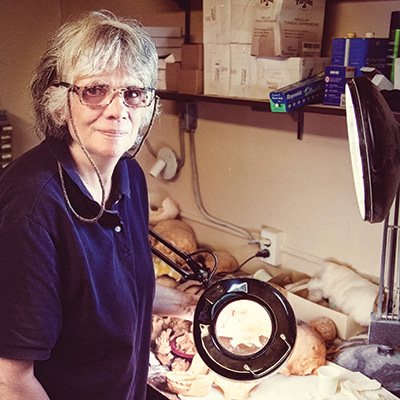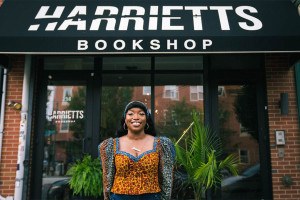Best of Philly Snapshot: Janet Monge, Best Museum Curator
You’ve caught Janet Monge at a rare moment when her purple reading glasses are down. They’re dangling from a lanyard right now, a telltale sign she’s on break from the clay and dust, which doesn’t prevent a colleague from interrupting her at the cafe of the Penn Museum:
“I was just asked a question on Twitter about a fellow who might be in the Morton Collection — a man by the name of Alexander Pearce?”
Like a human Rolodex, Monge mentally cycles through the 10,000 people she works with under the roof of the museum, all ranging in age, ethnicity and general put-togetherness. Some have spines; others don’t. The vast majority are dead. Pearce is one of those, and super-famous. “Oh yes, we have Pearce,” Monge says. “He was executed. He was a cannibal.”

Photograph by Sean Murray
A 60-year-old cat lover (three of her rescued felines have Darwin-themed names) with a wavy curtain of hair, Monge is the keeper and curator of the physical anthropology section at the Penn Museum — essentially, the resident bone connoisseur. She has enchanted us with vast anthropological exhibitions that combine the interactivity of the Please Touch Museum with the Mütter’s sense of macabre, presenting shows and lectures for families and scholars alike on topics such as slavery, evolution and “Beauty Through the Ages.” As the museum has pushed to rebrand itself as a public treasure trove and not just a world-renowned research institution, Monge has become the embodiment of that duality.
Down in the museum catacombs, she directs a nonprofit casting business that’s provided more than 100 students with jobs and digitized thousands of skeletal remains using 3-D tomography — creating a “virtual museum” for outside research. A few years back, Monge garnered the largest National Science Foundation grant in the history of the museum ($1.7 million) to curate an exhibit on human evolution. She’s also an adjunct professor and an actively excavating paleoanthropologist along the Swahili coast of Kenya. “You can see why we’re not going this summer,” she says, with a howl of laughter. (Remember that Tom Hanks movie? The one based on the true story of the boat captain abducted by Somali pirates? Monge’s dig is 60 miles from Somalia’s border.)
Pearce, for all his postmortem fame and chilling last words (“Man’s flesh is delicious, it tastes far better than fish or pork”), is just a boring old white guy to Monge. That’s compared to, say, the enigma of bludgeoned Neanderthal skulls. Perhaps that’s why Pearce isn’t on display but is instead boxed up in Monge’s office, away from the craniums that she unveils to me. Some of her favorites (yes, she has favorites) include tattooed New Zealand trophy skulls (hair still attached); Mesopotamian skulls from 2,000 B.C. that she surmises are ancient victims of domestic abuse; and a skull pockmarked with gnarly indentations. “This one died of syphilis,” she says, holding it out to me. I take it, reluctantly.
An encyclopedic knowledge of the city’s largest skull collection (more than 2,000 of them) isn’t the extent of Monge’s expertise. In her spare time, she’s basically the Sherlock of Skeletons, shedding light on centuries-old cold cases by identifying anonymous ancient bodies. Five years ago, she got a call to analyze the remains of a mass grave of 19th-century Irish railroad workers that was unearthed in Malvern. Her groundbreaking conclusion, covered by the New York Times and the BBC, was that the newly discovered dead had in fact been murdered and hadn’t died in a cholera panic, as had been the running myth of the immigrants’ demise for generations. “Skulls tell me a story about when they were alive. I’m just giving them voice,” Monge says.
Her rarified dexterity as an anthropologist beyond the lab and classroom began in 1985, when she was a 32-year-old PhD student hired to analyze the MOVE-bombing burn victims. She reached differing conclusions about certain remains than did the city’s special commission on MOVE, an experience that Monge says taught her two lessons: “Forensics is always political,” and “If you don’t charge the shit out of people, they think you’re not good.”
At this point, though, Monge volunteers her talents on a regular basis, serving as an expert witness in criminal defense cases and as a forensic consultant to police, and even riding along with homicide detectives. She doesn’t need money to validate her work: “I have a social responsibility as a forensic anthropologist to do anything for Philadelphia,” she says, “and I’m sure as heck not charging for it.” University of Pennsylvania Museum of Archaeology and Anthropology, 3260 South Street, West Philly, 215-898-4000.
See the rest of our Best of Philly picks in the August 2014 issue of Philadelphia magazine, on newsstands now, or subscribe today. Then join us at the Best of Philly Bash at Citizens Bank Park on August 12th!


